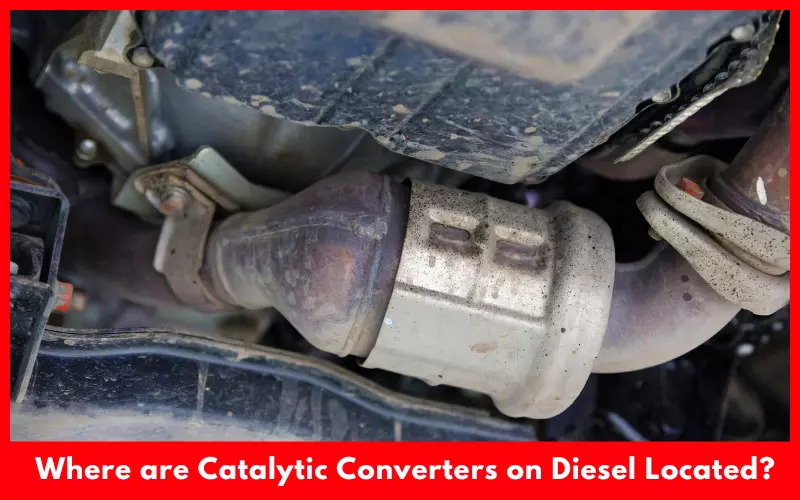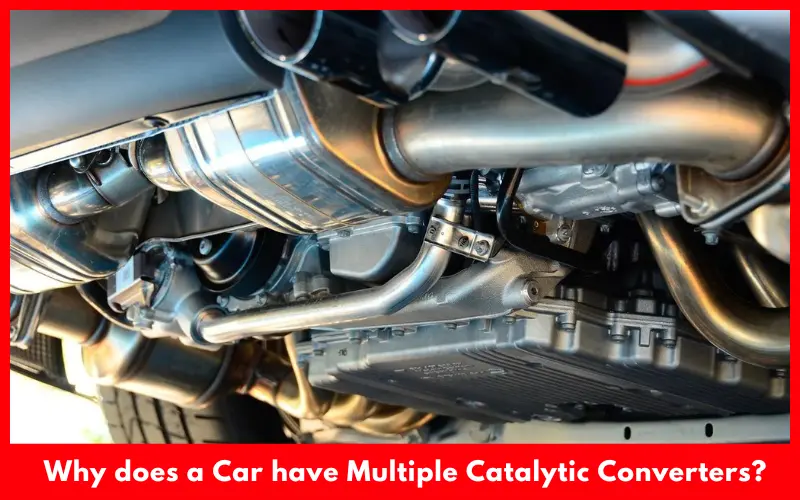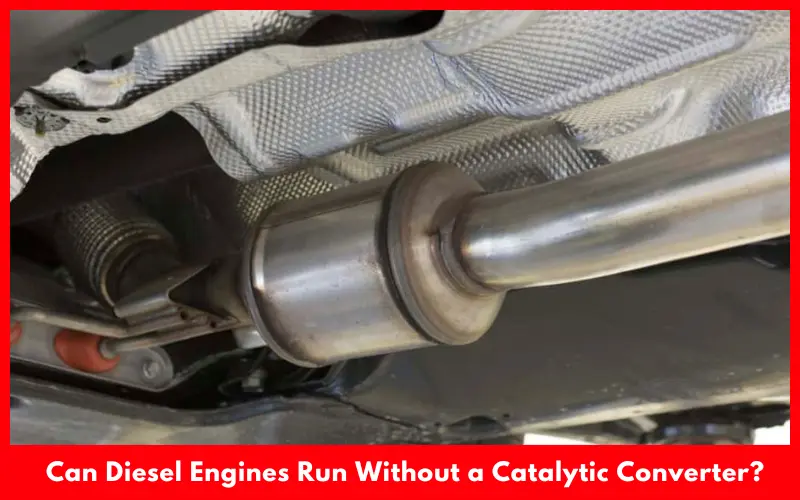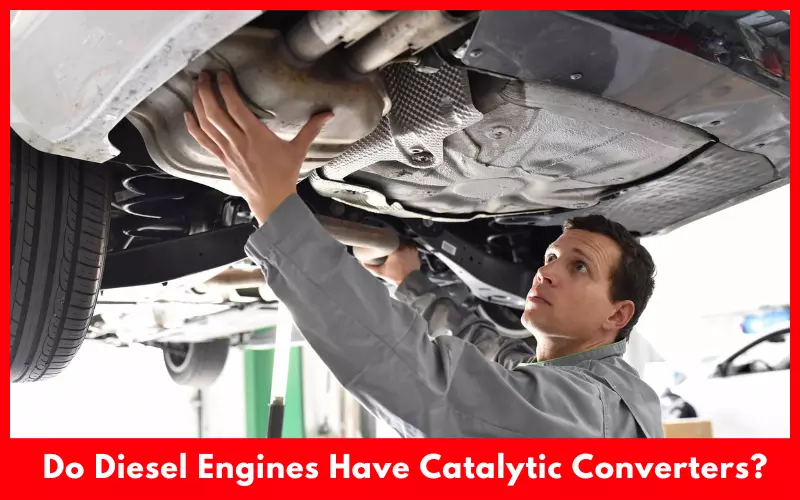Catalytic converters, known for their crucial role in reducing harmful exhaust emissions in petrol engines, are often the center of discussion. But do diesel engines have catalytic converters?
Yes, today’s diesel engine comes with catalytic converters. Even catalytic converters become a must-need for the vehicle. You can’t drive a car in the USA that doesn’t have these precious components.
Otherwise doing so can cost you up to 1,000 dollars in fines. The catalytic converter comes in various types and works differently than those found on gasoline engines. Let’s gets detail!
Article Summary
- Do Diesel Engines Have Catalytic Converters?
- Where are Catalytic Converters on Diesel Located?
- What Type of Catalytic Converter does the Diesel Engine use?
- The Purpose of a Catalytic Converter on Diesel Engine
- Why does a Car have Multiple Catalytic Converters?
- How Does Catalytic Converters Work in A Diesel Car?
- Can Diesel Engines Run Without a Catalytic Converter?
- FAQs
Do Diesel Engines Have Catalytic Converters?
The presence of a catalytic converter on a diesel engine depends on the engine’s model and manufacturing years. Till 1970, there was no law to control emission production. So the car manufacturer didn’t focus on the toxic emission issues.
In 1970, the Environmental Protection Agency (EPA) establishes Clean Air Act to control air emissions from stationary and mobile sources. In 1990, the authority makes it mandatory for every car to pass emission tests to get a permit for driving on the road.
Since then, the manufacturer started adding and fixing catalytic converters to the diesel engine that help convert pollutants into harmless gasses. So the diesel engine made after 1990 should have a catalytic converter. Currently, all modern cars and all types of engines come with catalytic converters to pass the emission test.
Where are Catalytic Converters on Diesel Located?
The location of catalytic converters on diesel engines depends on the model, manufacturing years, and brands. The first catalytic reduction system in a diesel engine is the diesel oxidation catalyst (DOC) and it’s located downstream from the exhaust manifold.

In today’s cars, catalytic converters are also located near the engine’s exhaust manifold. The reason is that the catalytic converter exposes it to extremely hot exhaust gases and heats up quickly. Placing it near the engine allows it to reduce undesired emissions during the engine’s warm-up period.
The closer the catalytic converter is placed to the engine, the faster it can heat up and activate the catalyzation compounds. You can also find a catalytic converter on the exhaust or between the mufflers. Catalytic converters are made of valuable metals, making them a special target for thieves.
What Type of Catalytic Converter does the Diesel Engine use?
The diesel engine usually has a two-way catalytic converter because vehicles have only oxidation reactions in the converter. It oxidizes HC, NO, and CO to H2O, NO2, and CO2. The oxygen removal reaction reduces the NOx-related contaminants.
The low-pressure and high-pressure exhaust gas recirculation also helps clean the NOx-related pollutant. So diesel engines don’t require a three-way catalytic converter.
In comparison, two-way catalytic converters depend on physical reactions to turn pollutants into risk-free gases while three-way converters depend on chemical reactions.
Diesel engines also have more sulfur than gasoline engines. Sulfur participates in a chemical reaction inside the three-way catalytic converter. So it can’t clean the exhaust fumes more effectively like the two-way type.
However, some of today’s diesel engine uses ultra-low sulfur diesel (ULSD) fuel that contains a little sulfur. This type of engine can use the three-way catalytic converter. Compared to the USA, ULSD is normal in Europe. So, most of the diesel engines in Europe have three-way catalytic converters. But regular diesel fuel is normal in the USA; hence two-way catalytic converter is dominant here.
The Purpose of a Catalytic Converter on Diesel Engine
A catalytic converter provides several benefits to the diesel engine. Firstly, it helps eliminate emissions of harmful pollutants to enhance air quality and public health. The catalytic converter also improves the engine’s overall performance and fuel efficiency while helping pass the emissions test.

It can reduce engine noise to make driving comfortable. Another benefit is catalytic converter help boost the engine’s longevity by protecting the engine parts from wearing out.
However, catalytic converters may become jammed over time and need maintenance to retain their functionality. To avoid this problem, many diesel engines use a combination of DPFs and DOCs to reduce hydrocarbon emissions and capture particulate matter.
Why does a Car have Multiple Catalytic Converters?
A catalyst causes a chemical reaction inside the catalytic converter without being changed chemically. This honeycomb-like object consists of various elements like platinum, rhodium, and cerium that turn into harmful emissions during the chemical reaction. Catalytic converters have two chambers, oxidation, and reduction.

When the HC (hydrocarbons or fuel), CO (Carbon Monoxide), NOx (Oxides of Nitrogen), and O2 (oxygen) enter the converter, the reduction chamber converts them with its best effort. Then the oxidation chamber converts the CO, O2, and HC into CO2 and H20 as well as releases harmful emissions through the tailpipe.
The automakers trying to increase compression maintaining the emission law strictly. That’s why they add more catalytic converters in a vehicle to reduce emissions while increasing compression. It’s a relatively new concept and you won’t find lots of vehicles with multiple catalytic converters. Toyota Camry has 3 inline catalytic converters while Ford 2.
How Does Catalytic Converters Work in A Diesel Car?
DOC is the most commonly used catalytic converter. The metal casing’s interior of the catalytic converter has two ceramic blocks and thousands of micro-cellular units. The ceramic blocks are coated with palladium and platinum that convert carbon monoxide and hydrocarbons to carbon dioxide and water.
It also heats the blocks and catalyzes the chemicals to convert them into nontoxic gasses. Compared to gasoline catalytic converters, diesel catalysts don’t use rhodium. It also has a diesel particulate filter to remove particular matter that may come from the engine.
However, catalysts can’t handle NOx. So diesel engines use exhaust gas recirculation (EGR) to control NOx emissions. Many manufacturers also use nitrogen injection that contains urea to create ammonia and convert the NOx into nitrogen and water.
Also Read: How To Watch MotoGP?
Can Diesel Engines Run Without a Catalytic Converter?
The catalytic converter isn’t a compulsory component for a diesel engine as it doesn’t participate in the vehicle’s locomotion process. So a diesel engine can run efficiently without a catalytic converter. A bad catalytic converters affect a car’s engine performance and the car can make irritating sound without using it.

If your vehicle doesn’t have a catalytic converter, it can also fail the emissions test. The reason is that it’s illegal to drive a car without a catalytic converter in USA. A vehicle without a catalytic converter produces excessive emissions through the exhaust pipes that can make the environment harmful.
Hence, according to the 1970 Clean Air Act, the Environmental Protection Agency makes it compulsory for every vehicle to have a catalytic converter. So, if you run a diesel engine car without a catalytic converter, you may charge fine and fail the emissions test.
You might not want to pay a fine and hear annoying noise by taking off the catalytic converter. This component will not only help you pass the emission test but also help pollute the environment.
Also Read: Car Shaking after Oil Change
FAQs
Is a diesel catalytic converter worth anything?
The catalytic converter is a crucial component for diesel engines as it helps control the emission release and makes the vehicle legal for driving in the USA. In terms of price, diesel catalytic converter is fairly inexpensive than gasoline catalytic converter. Diesel catalytic converter is made of cheaper material and its precious metals, platinum, and palladium are also less dense.
Are petrol and diesel catalytic converters the same?
The petrol and diesel catalytic converters are almost the same. Both of the converters come with the same shape and components as well as used for the same purposes. But the difference is that catalytic converters are placed on the spark-fired gasoline engine while diesel engine has one downstream of the exhaust manifold.
Does Ford diesel have catalytic converters?
Yes, Ford using catalytic converters since 1976 to reduce air pollution and convert dangerous combustion into harmless chemicals.
Final Words
The catalytic converter is a blessing for today’s automobile and thanks to the manufacturer, diesel engines have catalytic converters. So diesel engine doesn’t pollute the atmosphere and damages public health as much as the gas-powered engine does.
Catalytic converters aren’t much expensive and last up to 10 years or over 160,000 km in driving, making those worthwhile components from all around. However, this component requires a little bit more maintenance and extra care as it’s attractive to thieves.

